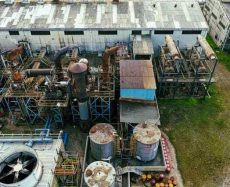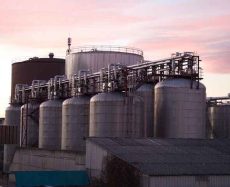- admin
- May 10, 2022
Types of Industrial Storage Tanks Explained
Industrial storage tanks are containers that hold liquids, compressed gases, or media that are used to store heat or cold for short or extended periods of time. Reservoirs and constructed containers both fall within this category. To better endure hydraulic hydrostatically produced pressure of confined liquid, large tanks are vertical cylindrical or have rounded corners transitioning from vertical side wall to bottom profile. Various fluids can be stored in industrial fuel storage tanks (also known as petroleum tanks). They are commonly used to store both non-organic and organic liquids.
Vertical and horizontal cylindrical storage tanks are available in a variety of designs, including open top and closed top, flat bottom, cone bottom, slope bottom, and dish bottom. There are fixed roof tanks and floating roof tanks in refineries, notably for liquid fuels. There are also aboveground storage tanks, field erected tanks, and fiberglass water tanks. Most liquid-handling container tanks are built to withstand a range of pressures during transit. Tanks for a certain fluid are selected based on the substance’s flash point.
Types of storage tanks for refineries
Tanks with a fixed roof are designed for liquids with extremely high flash points (e.g. fuel oil, water, bitumen etc.) Roofs with cones, domes, and umbrellas are common. The heat is delivered by steam coils within the tanks, which are insulated to avoid clogging of particular materials. Dome roof tanks are designed for storage pressures that are somewhat higher than atmospheric pressure (e.g. slop oil).
External floating roof tanks (often referred to as FR Tanks) and internal floating roof tanks are the two types of floating roof tanks (IFR Tanks).
Liquids with low flash points are stored in IFR tanks (e.g., ATF, MS. gasoline, ethanol). These tanks are nothing more than cone roof tanks with a floating roof that moves up and down with the liquid level. The vapor from low-flash-point fuels is trapped by this floating ceiling. Floating roofs are supported by legs or cables that run along the ground. FR tanks do not have a permanent roof (the top is open) and instead rely on a floating roof. These tanks are used to hold liquids with a medium flash point, such as naphtha, kerosene, diesel, and crude oil.
The open roof type tank, which is typically used to hold ore slurries, is one of the best varieties found in mining sites. These are the most straightforward storage tanks to construct.
Other Kinds:
Industrial Chemical Storage Tanks
Propane, fertilizers, petroleum products (gasoline, diesel), liquefied natural gas, crude oil, and other chemicals are stored in industrial chemical storage tanks. Chemical industrial storage tanks come in a variety of designs and sizes. Mixing, processing, static storage, and transfer of finished chemical products and raw materials are all done in these storage tanks.
Industrial Oil Storage Tanks
Oil storage tanks are reservoirs or containers that temporarily store oil during the many stages of processing into various types of oil products, or before it is consumed or used. The materials and construction of industrial oil storage tanks are determined by their intended use as well as other safety, environmental, and regulatory considerations.
From the initial production of crude oil through the distribution and refinement of various petroleum oil products, oil storage tanks of various sizes, forms, materials, and kinds are used.
Carbon steel, stainless steel, reinforced concrete, and plastic are among the materials used in modern industrial storage tanks for oil. They are also cut on mostly impermeable rock salt deposits for subsurface oil storage. Over time, several types of oil storage tanks have been constructed.
Industrial Water and Liquid Storage Tanks
Water and liquid storage tanks are used to store a range of liquids such as kerosene, jet A, diesel, gasoline, waste oil, and for underground burial and pressured purposes, as well as for underground burial and pressurized applications. Different types of liquid storage tanks exist, each with its own set of purposes.
Industrial Plastic Storage Tanks
For household, residential, industrial, and commercial needs, water storage is critical. Plastic water storage tanks are one of the greatest options for traditional water storage. When compared to cement and concrete tanks, plastic tanks are lighter, more durable, and take up less space. Furthermore, as compared to traditional storage tanks, plastic tanks offer more flexibility. Plastic water tanks have become popular due to their numerous advantages.
Category
- Above Ground Fuel Tanks
- Above Ground Gas Storage Tank
- Above Ground Storage Tanks
- Above Ground Water Storage Tanks
- Agricultural Tanks
- Chemical storage Tanks
- Diesel Fuel Storage Tanks
- Diesel Storage Tanks
- Exernal FloatingRoof Tanks
- Farm Water Tank
- Fiberglass Oil Tanks
- Fiberglass Septic Tanks
- Fiberglass Underground Fuel Storage Tanks
- Field Erected Tanks
- Floating Roof Tank
- Fuel tank
- Industrial Chemical Storage Tanks
- Industrial Gas Tanks
- Industrial Plastic Tanks
- Industrial Storage Tanks
- Industrial Tank heating pads
- industrial tanks
- Natural gas
- Natural gas vs Propane
- oil storage tank
- Oil Storage Tanks
- Peracitic Acid
- Petroleum Tanks
- Residential gasoline storage tanks
- Residential Water Storage Tanks
- Sodium Hydroxide Storage Requirements
- Sodium Hypochlorite Storage Tanks
- Steel Storage Tanks
- storage tank failure prevention
- Storage Tanks
- Sulfuric Acid Tanks
- Uncategorized
- UnderGround Storage Tanks
- Water Storage Tanks

 Tank Size Calculator
Tank Size Calculator






